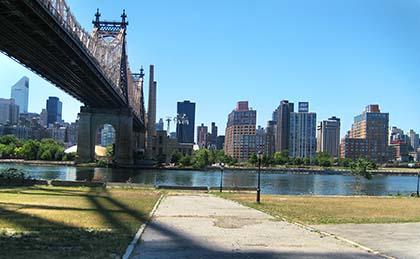By Rebecca Henely
The city Parks Department is requesting proposals to test which contaminants are in the soil near the seawall at Queensbridge Park, taking the first step in the process to repair a 200-foot dilapidated portion of the wall, the office of U.S. Rep. Carolyn Maloney (D-Astoria) said last week.
“Thanks to the leadership of Congresswoman Maloney and Borough President Helen Marshall, who are working with local elected officials, we believe we will soon be in a position to reconstruct the seawall so that local residents can enjoy access to their waterfront,” Parks Commissioner Adrian Benepe said in a statement. The department announced the request for proposals at a meeting Friday.
The poor state of that part of the Queens seawall, which is located along the East River beneath the Ed Koch-Queensboro Bridge, has long been a concern for area electeds. While the deteriorated area of the seawall, which failed more than a decade ago, has been fenced off to protect Queensbridge Houses residents, Maloney and other elected officials have criticized how long it has taken to repair the seawall and restore residents’ access to the waterfront. The wrecked seawall is also potentially endangering the cathodic device for the subway system which runs beneath the bridge.
The situation improved in February, when the Parks Department committed to repairing the seawall and a taskforce was created for the project. Members of the taskforce include the congresswoman, other elected officials, the U.S. Army Corps of Engineers, the mayor’s office and the Parks Department.
“The Queens Seawall is a disaster waiting to happen,” Maloney said in a statement. “At long last, we are making progress on this project and I look forward to working with the city to complete these long‑overdue repairs as soon as possible.”
The first part of the process will be to hire a contractor who will take samples of the soil near the broken wall to see to what extent the area is contaminated, test the contaminants and create a final report that will specify how to legally and ideally dispose of the area contamination when fixing the seawall and the shoreline. Maloney’s office said these tests should begin in late June and should be completed after 12 weeks. Some of this contamination may have come from the lead paint pieces falling off the bridge.
The repair is funded in part by mitigation the city Department of Transportation owes to the Parks Department to restore part of the natural shoreline. The DOT took part of it away when it repaired Manhattan’s FDR Drive. Maloney, state Assemblywoman Cathy Nolan (D-Ridgewood) and other officials have also obtained a collective $1.125 million for the project. Despite this, the department will need to locate more money to cover the seawall’s complete repair.
Reach reporter Rebecca Henely by e-mail at rhenely@cnglocal.com or by phone at 718-260-4564.

































